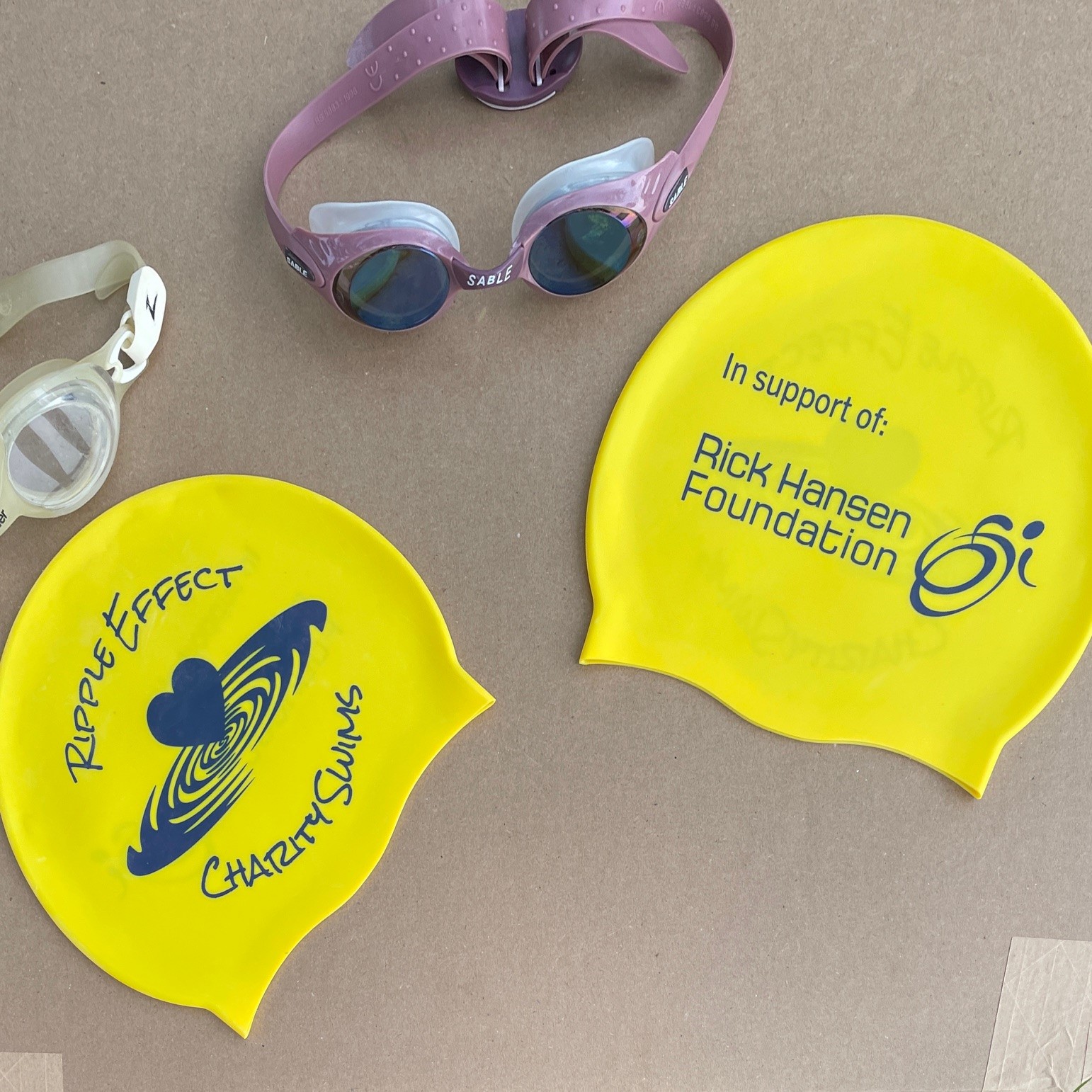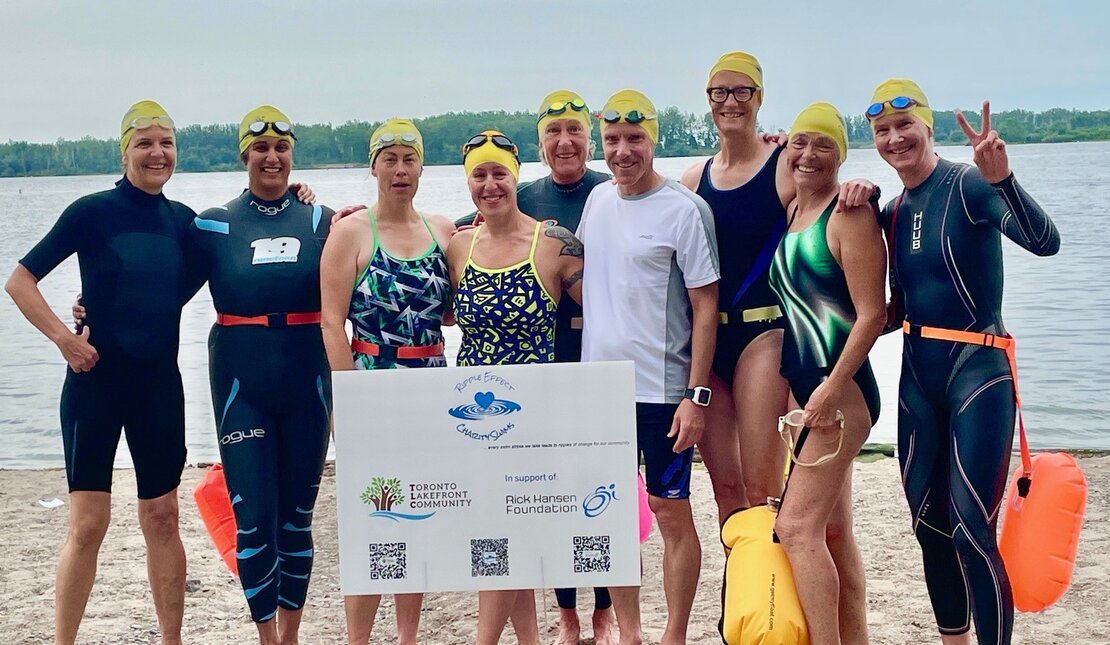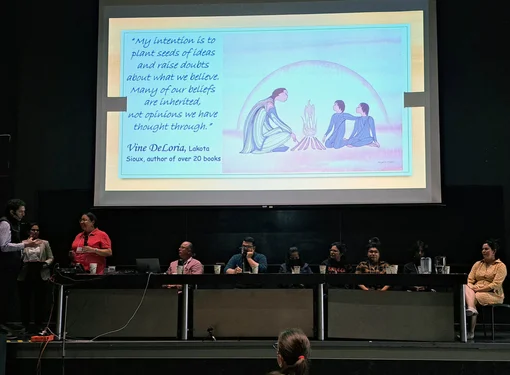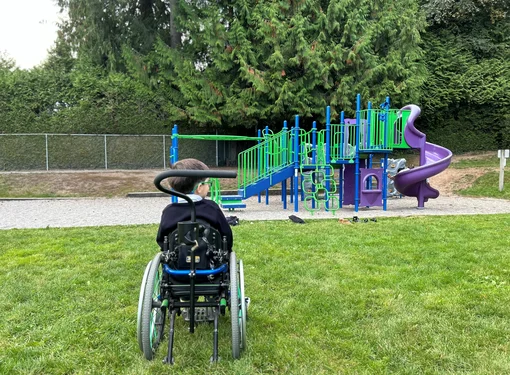The Ripple Effect in Lake Ontario
On a humid August morning with the sun breaking through the clouds over Toronto’s eastern skyline, a group of swimmers gathered at Woodbine Beach. The swimmers wore bright yellow swim caps, one side emblazoned with the words “Ripple Effect Charity Swims,” a name that is a nod to their mission to create waves of change for accessibility at Toronto’s beaches. The other side bore the logo of the Rick Hansen Foundation (RHF), which gratefully benefited from their fundraising efforts.

Among the swimmers was Jane Anderson, a self-proclaimed “middle-of-the-pack” open-water swimmer who, like many in this tight-knit group, felt at home in the cold waters of Lake Ontario. “We have a very strong open-water swimming community here in the Beaches,” said Jane. “On any given day, there’s usually a group of us swimming, depending on the conditions.”
The Toronto Lakefront Community group has a passion for the lake that extends beyond recreation. By organizing charity swims at several of the city’s Blue Flag beaches—sites recognized internationally for meeting high environmental, safety, and cleanliness standards—Jane and her group are raising awareness of the need to enhance beach accessibility so everyone can enjoy Toronto’s waterfront.
The Greater Toronto Area has a population of about 6.4 million. According to Canada’s 2022 survey on disability, approximately 650,000 people in the city have a disability.
“More and more people are moving into the city, and people are escaping to the lake to cool off, especially on these hot days, which are more often than not with climate change,” said Jane. “Not everybody can afford a cottage, so we feel everyone should have equal opportunity to enjoy the lake because it is really one of our city’s greatest assets. And I think there’s an attitudinal barrier around making our beaches accessible because there’s an assumption that people with disabilities wouldn’t want to go swimming. And that is completely false.”
The Power of a Single Act
Ripple Effect Charity Swims began on the first Saturday of August, with the five planned swims held at Cherry Beach, Centre Island, Woodbine, Kew-Balmy, and Bluffers Park. Central to the Toronto Lakefront Community’s mission is the belief that small actions can spark big change, echoing the famous words of cultural anthropologist Margaret Mead.
“Just like the name suggests,” said Jane, “every stroke we take is a ripple that can inspire change, whether it’s improving access for someone with a disability or simply having a conversation about disability inclusion.”
The cause is personal for the group. Many of the swimmers have spent years training in these cold waters. Among the Toronto open-water swimming community are people currently preparing to swim across the vast expanse of Lake Ontario. Within the Ripple Effect swim group, some swimmers recently completed long open-water swims of up to 16 kilometres. But everyone in the group is a dedicated outdoor swimmer who knows that accessibility at most beaches is lacking.
“There’s nothing at Cherry Beach to support you when you enter the water,” said Jane. “Even for able-bodied people, it’s challenging because it’s rocky, and zebra mussels can cut your feet. But for someone with mobility issues? It’s next to impossible.”
In Toronto, plastic mats were introduced at a few beaches as a low-tech solution to accessibility. Still, they often fall short of providing full access since they don’t reach the water’s edge and don’t provide easy or independent wheelchair access.
Jane and the Ripple Effect swimmers experienced this firsthand when they met an avid swimmer and wheelchair user at Woodbine Beach who expressed frustration that the current plastic mat didn’t reach the lake. Another beach user, who is blind, described how the bumpy joints between the plastic panels made navigating with a cane difficult and even dangerous. In contrast, many other cities and municipalities have implemented different solutions such as the Mobi-Mat, which RHF highlighted in this recent story about Parksville’s accessibility improvements.
A Long Overdue Conversation
While Ripple Effect swims, which are often about an hour in duration, are an invigorating way of fundraising, the goal of the group is to promote dialogue about the broader issue of beach accessibility. “We’re not out here just swimming,” said Jane. “We’re trying to spark creativity and imagination within the city about what it really means to be accessible. That’s where organizations like the Rick Hansen Foundation come in.”
Ripple Effect chose RHF as the recipient of its fundraiser, as the Foundation has long been a leader in advocating for disability inclusion. Through its RHF Accessibility Certification and Accessibility Advisory Services, RHF provides recommendations from the input of experts, including those with lived experience, to improve public spaces.
“It’s not just about throwing down mats,” said Jane. “There are procedures, maintenance protocols, and budget considerations in a big city like Toronto. It is going to take time, but we have to start somewhere.”
That somewhere began with Ripple Effect’s fundraising goal of $2,500. By the end of August, the swims have raised almost $5,000 for RHF, proving the interest and need for improved beach accessibility.
An Inclusive Future on the Horizon
On the morning of the group’s third swim at Kew-Balmy Beach, Robert Hampson, RHF Ambassador and Paralympic swimmer who has been blind since age four, joined the group. Before heading into the water, Robert shared his story, describing how swimming gave him a sense of freedom and weightlessness that is often missing in daily life. His words further solidified Ripple Effect’s belief in creating accessible outdoor spaces.
“We’re missing people from our community,” said Jane. “We want everybody to experience what we feel when we swim – the joy, the freedom, the connection with nature.”

The Ripple Effect Charity Swims have brought attention to the accessibility issues facing Toronto’s beaches, but there is still a long way to go before everyone can access every beach. Jane acknowledged that change won’t happen overnight. “There’s red tape, budgets, and other priorities,” she said. “But I’m optimistic. We know the city is moving in the right direction, and we’re here to help keep the conversation going.”
The Ripple Effect swimmers plan as summer sets on the last of the swims in the series at Bluffers Beach. They hope to continue their advocacy work to improve beach access. For now, they’ll keep diving into the lake, knowing that with each stroke, they’re inching closer to a more inclusive future for everyone who shares their love of the open water.







